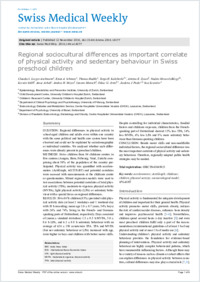Regional sociocultural differences as important correlate of physical activity and sedentary behaviour in Swiss preschool children
- Leeger-Aschmann, Claudia S. Universität Zürich
- Schmutz, Einat A. Universität Zürich
- Radtke, Thomas Universität Zürich
- Kakebeeke, Tanja H. Child Development Centre, University Children's Hospital Zürich
- Zysset, Annina E. Universität Zürich
- Messerli-Bürgy, Nadine Universität Fribourg, Schweiz
- Stülb, Kerstin Universität Fribourg, Schweiz
- Arhab, Amar Centre Hospitalier Universitaire Vaudois (CHUV), Lausanne
- Meyer, Andrea H. Universität Basel
- Munsch, Simone Universität Fribourg, Schweiz
- Jenni, Oskar G. Universität Zürich
- Puder, Jardena J. Centre Hospitalier Universitaire Vaudois (CHUV), Lausanne
- Kriemler, Susi Universität Zürich
-
12.11.2016
Published in:
- Swiss Medical Weekly. - 2016, vol. 146, no. w14377, p. 1-8
English
QUESTION: Regional differences in physical activity in school-aged children and adults even within one country with the same political and health care system have been observed and could not be explained by sociodemographic or individual variables. We analysed whether such differences were already present in preschool children. METHODS: Swiss children from 84 childcare centres in five cantons (Aargau, Bern, Fribourg, Vaud, Zurich) comprising about 50% of the population of the country participated. Physical activity was quantified with accelerometers (ActiGraph, wGT3X-BT) and potential correlates were assessed with measurements at the childcare centre or questionnaires. Mixed regression models were used to test associations between potential correlates of total physical activity (TPA), moderate-to-vigorous physical activity (MVPA), light physical activity (LPA) or sedentary behaviour with a special focus on regional differences. RESULTS: 394 of 476 children (83%) provided valid physical activity data (at least 2 weekdays and 1 weekend day with 10 h recording; mean age 3.9 ± 0.7 years, 54% boys) with 26% and 74% living in the French- and German-speaking parts of Switzerland, respectively. Days consisted of (mean ± standard deviation) 1.5 ± 0.5 h MVPA, 5.0 ± 0.6 h LPA, and 6.3 ± 0.8 h sedentary behaviour with an average of 624 ± 150 counts/min TPA. TPA and MVPA (but not sedentary behaviour or LPA) increased with age, were higher in boys and children with better motor skills. Despite controlling for individual characteristics, familial factors and childcare exposure, children from the French-speaking part of Switzerland showed 13% less TPA, 14% less MVPA, 6% less LPA and 8% more sedentary behaviour than German-speaking children. CONCLUSION: Beside motor skills and non-modifiable individual factors, the regional sociocultural difference was the most important correlate of phyical activity and sedentary behaviour. Therefore, regionally adapted public health strategies may be needed.
- Faculty
- Faculté des lettres et des sciences humaines
- Department
- Département de Psychologie
- Language
-
- English
- Classification
- Medicine
- License
- License undefined
- Identifiers
-
- RERO DOC 323671
- DOI 10.4414/smw.2016.14377
- Persistent URL
- https://folia.unifr.ch/unifr/documents/307584
Statistics
Document views: 144
File downloads:
- swiss_medical_regionalsocioculturaldifferencesasimportantcorrelateofphysicalactivityandsedentarybehaviourinswisspreschoolchildren.pdf: 115
